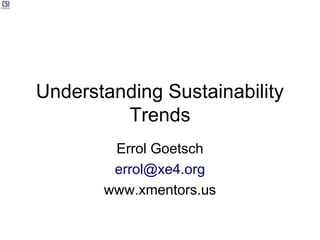NPO Sustainability Trends
- 1. Understanding Sustainability Trends Errol Goetsch errol@xe4.org www.xmentors.us
- 2. Key trends in development âĶ. (1) Donor Fatigue Donor expectations rising when NPO performance is falling Donor Expectations Falling NGO Rising donor Initially naÃŊve, capacity expectations trusting NPOâs will deliver; impose few reporting and proof requirements. Sullivan Code made CSI cosmetic; no investment in âback-officeâ design, funding Increasing donor field-office delivery instead. frustration and NPO Performance NGO anxiety at Initially well-run, cross-over in regulated environment, then heavily funded from abroad with weak auditing, with little investment in institutional capacity, loss of talent and diversion Rising social Falling NGO of money since 1994 needs performance 70âs 80âs 90âs 00âs 2
- 3. Key trends in development âĶ. (2) Downspend Donors hold back when NGOâs canât deliver Richer NGOâs Richer NGOâs Have the resources to market market themselves and themselves well maintain relationships with donors. Income Donors struggle to see visibility and NPO Performance impact for their Initially well-run, funds in regulated environment, then heavily funded from abroad with weak auditing, with little investment in institutional capacity, loss of talent and diversion Poorer NGOâs market of money since 1994 themselves poorly Number 3
- 4. Key trends in development âĶ. (3) Flight to Quality Donors prefer NGOâs who promise visibility and show impact Richer NGOâs Richer NGOâs Have the resources to market market themselves and themselves well maintain relationships with donors. Income Donors shift to richer NGOâs NPO Performance Initially well-run, in regulated environment, then heavily funded from abroad with weak auditing, with little investment in institutional capacity, loss of talent and diversion Poorer NGOâs market of money since 1994 themselves poorly Number 4




